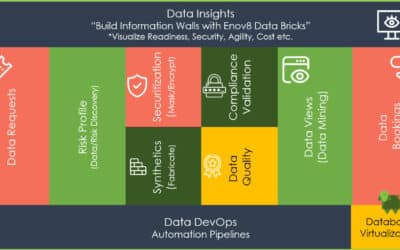
The Difference Between Release & Deployment Management
APR, 2023
by Jane Temov.
Jane Temov is an IT Environments Evangelist at Enov8, specializing in IT and Test Environment Management, Test Data Management, Data Security, Disaster Recovery, Release Management, Service Resilience, Configuration Management, DevOps, and Infrastructure/Cloud Migration. Jane is passionate about helping organizations optimize their IT environments for maximum efficiency.
In the fast-paced world of IT service management, there are several key processes that are essential for delivering high-quality services to customers and end-users. Two of the most critical processes are release management and deployment management. These processes are often used interchangeably, but they are actually quite different in terms of their objectives, activities, and focus.
Enov8 Enterprise Release Manager
*Innovate with Enov8
Streamline delivery of IT change through embracing “Scaled Agile” best practice.
In this post, we will explore the differences between release management and deployment management, and explain why understanding these differences is important for organizations that want to improve their IT operations and deliver better services to their customers.
What is Release Management?
Release management is a critical process in IT service management that is responsible for planning, scheduling, and controlling the deployment of new or updated IT services, systems, applications, or hardware components into production environments. The goal of release management is to ensure that new or updated services and features are delivered to customers and end-users in a timely, consistent, and high-quality manner.
The release management process begins with the identification of the scope of the release, defining release objectives, and developing a release schedule that takes into account business needs, risk factors, and resource availability. Release coordination is essential, and this involves ensuring that all parties involved in the release process, including developers, testers, operations teams, and stakeholders, are aligned and working together to achieve the release objectives.
Release communication is also a crucial aspect of the release management process. This involves communicating with stakeholders about the release, providing updates on progress, and managing expectations. Before deployment, release testing and validation are carried out to ensure that the release meets functional, technical, and quality requirements, and that it is compatible with existing systems and infrastructure.
Finally, release deployment involves deploying the release into production environments in a controlled and systematic manner, with appropriate fallback and recovery procedures in place. After deployment, release evaluation is conducted to evaluate the success of the release, measure performance against defined objectives, and identify opportunities for continuous improvement.
Overall, release management is a comprehensive process that enables organizations to deliver new or updated services and features to customers and end-users in a controlled and consistent manner.
A Release Management Process
What is Deployment Management?
Deployment management is a process in IT service management that is responsible for the physical implementation and installation of new or updated IT services, systems, applications, or hardware components into production environments. The objective of deployment management is to ensure that the release is installed correctly and that the new or updated services and features are available to customers and end-users in a timely and efficient manner.
The deployment management process involves executing the deployment plan, managing the deployment process, coordinating with other teams involved in the deployment, verifying that the deployment is successful, and conducting any necessary post-deployment activities.
Executing the deployment plan involves following the plan that was developed during the release management process. This may include tasks such as configuring systems, installing software, and updating databases.
Managing the deployment process involves ensuring that the deployment is carried out according to the plan, and that any issues or challenges are identified and resolved quickly.
Coordinating with other teams involved in the deployment is also essential, and this may include teams such as development, testing, and operations.
Verifying that the deployment is successful involves conducting tests and checks to ensure that the new or updated services and features are available to customers and end-users and that they are functioning as expected.
Finally, conducting post-deployment activities involves activities such as configuring systems, updating documentation, and training users.
In summary, deployment management is a crucial process that ensures that new or updated services and features are delivered to customers and end-users in a timely and efficient manner. By managing the physical implementation and installation of releases, deployment management enables organizations to improve the quality and reliability of their IT Environments, services, systems, applications, and hardware components.
The Difference Between Release Management and Deployment Management
While release management and deployment management are related processes that work together to deliver new or updated IT services, systems, applications, or hardware components, there are some key differences between them. These differences can be summarized as follows:
- Focus: Release management is focused on the planning, coordination, and control of the entire release process, from initial planning through to deployment. Deployment management, on the other hand, is focused specifically on the physical implementation and installation of the release into the production environment.
- Objectives: The objectives of release management are to ensure that new or updated services and features are delivered to customers and end-users in a timely, consistent, and high-quality manner. The objectives of deployment management are to ensure that the release is installed correctly and that the new or updated services and features are available to customers and end-users in a timely and efficient manner.
- Activities: The activities involved in release management include release planning, coordination, communication, testing and validation, deployment, and evaluation. The activities involved in deployment management include executing the deployment plan, managing the deployment process, coordinating with other teams involved in the deployment, verifying that the deployment is successful, and conducting any necessary post-deployment activities.
- Timeline: Release management is typically a longer-term process that spans the entire release cycle, from planning through to evaluation. Deployment management, on the other hand, is typically a shorter-term process that focuses specifically on the physical installation and implementation of the release.
Why are Release Management and Deployment Management Important?
Release management and deployment management are critical processes within IT service management because they enable organizations to deliver new or updated IT services, systems, applications, or hardware components to customers and end-users in a controlled, consistent, and high-quality manner. Effective release and deployment management can help organizations to achieve their business objectives, improve their IT operations, and deliver better services to their customers.
Release management is important because it ensures that new or updated services and features are delivered to customers and end-users in a timely, consistent, and high-quality manner. By coordinating activities across multiple teams, testing and validating the release, and deploying it into production environments in a controlled and systematic manner, organizations can reduce the risk of downtime, errors, and other issues that can negatively impact the user experience.
Deployment management is important because it ensures that the release is installed correctly and that the new or updated services and features are available to customers and end-users in a timely and efficient manner. By managing the physical implementation and installation of the release, organizations can improve the quality and reliability of their IT services, systems, applications, and hardware components.
Conclusion
In conclusion, release management and deployment management are two critical processes within IT service management that work together to deliver new or updated IT services, systems, applications, or hardware components to customers and end-users in a controlled, consistent, and high-quality manner. While release management is focused on the overall planning, coordination, and control of the entire release process, deployment management is focused specifically on the physical implementation and installation of the release into the production environment.
Understanding the differences between these two processes is essential for organizations that want to improve their IT operations and deliver better services to their customers. By effectively managing the release and deployment processes, organizations can reduce the risk of downtime, errors, and other issues that can negatively impact the user experience.
Enov8 Enterprise Release Manager is a platform that provides inbuilt capabilities for both release management and deployment management. It enables organizations to plan, coordinate, and control the entire release process, from initial planning through to deployment, while also managing the physical implementation and installation of the release into the production environment. With its comprehensive set of features and capabilities, Enov8 Enterprise Release Manager helps organizations to improve their release and deployment management processes, reduce risk, and deliver better services to their customers.
Other Reading
Enov8 Blog: What is Release Management – An ERM & SAFe Perspective
Enov8 Blog: Deployment Runbooks (aka Runsheets) Explained
Medium: The Difference Between Release Managers & Project Managers
Relevant Articles
8 DevOps Anti-Patterns to Avoid
It’s the normal case with software buzzwords that people focus so much on what something is that they forget what it is not. DevOps is no exception. To truly embrace DevOps and cherish what it is, it’s important to comprehend what it isn’t. A plethora...
An Introduction to Application Rationalization
In today's fast-paced digital landscape, organizations often find themselves grappling with a sprawling array of applications. While these applications are crucial for various business operations, the lack of a structured approach to managing them can lead to...
What Makes a Great Test Data Management Tool
What Makes a Great Test Data Management Tool? In today's fast-paced IT landscape, having a robust Test Data Management (TDM) tool is crucial for ensuring quality, compliance, and efficiency in software development and testing. At Enov8, we pride ourselves on providing...
The Top Application Portfolio Management Tools
Managing an application portfolio is essential for organizations aiming to optimize their IT operations, reduce costs, and enhance overall efficiency. Application Portfolio Management (APM) tools are designed to help organizations achieve these goals by providing a...
What Is a Test Data Manager?
Testing is a critical aspect of software development, and it requires the use of appropriate test data to ensure that the software performs optimally. Test data management (TDM) is the process of creating, storing, and managing test data to ensure its quality,...
Sprint Scheduling: A Guide to Your Agile Calendar
Agile sprints can be a powerful, productive and collaborative event if managed properly. However, when neglected or set up incorrectly they risk becoming chaotic and inefficient. Crafting an effective schedule for your sprint is essential to ensure the success of your...











